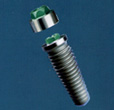
| |
||||
Replace® Select Screws |
 |
|||
|
Abstracts
New Finite Element Analysis to Determine Implant Preload-New Lang LA, Kang B, Wang R-F,and Lang BR. Finite element analysis to determine implant preload. J Prosthet Dent 2003;90:539-545. Abstract: Any attempt to understand
the biomechanics and structural properties associated with the dynamic
nature of loading must first begin with understanding the load applications
in the assembly of the implant complex prior to the implant functioning
in the presence of any external forces. The implant complex is an
assembly of multiple components that forms a mechanical screw joint.
The forces applied in the assembly process are essential in the
maintenance of the functional capacity of the implant system prior
to supporting a dental prosthesis. Although the assembly process
is well understood, the nature of the forces used to clamp the implant
components together and how they are generated and sustained is
not. Therefore, a study was initiated to examine the dynamic nature
of loading in the development of the implant complex prior to supporting
any external load related to the dental prosthesis. Two implant
designs were selected for finite element modeling to represent both
the external and internal designs in the screw joint assembly. The
geometry for the designs were obtained from mechanical drawings
provided by Nobel Biocare, AB. Using the software program HyperWorks®,
investigators modeled a Brånemark® System 3.75 X 10 mm
Mark III implant (SDCA 065), a CeraOne® abutment, (SDCA 068),
a Unigrip abutment screw (DCA 1045-0) for the external screw joint
design. A Replace Select™ System 4.30 X 10 mm tapered implant
(61084), a Straight Esthetic abutment (61117), and a TorqTite abutment
screw (62190) were modeled for the internal screw joint design.
Most previous publication involving FEA have modeled screw threads
and the screw bore using concentric rings because of the difficulty
in modeling the thread helix. However, because the abutment screw
would be tightened in order to induce the preload during the finite
element analysis (FEA) by simulating screwing the abutment screw
into the screw bore and clamping the abutment onto the implant,
the exact geometry of the thread helix was necessary. Concentric
ring simply cannot be screwed into a screw bore. Other essentials
of the FEA are the properties of the materials used in the implant
complex. These include the density, Young’s modulus, and Poisson’s
ratio, for the implant, abutment, abutment screw, and bone. A torque
wrench head was modeled to fit into the head of the abutment screws.
The abutment screw was subjected to a tightening torque moment in
increments of 1 Ncm from Zero (0) to 64 Ncm using the modeled wrench
and ABAQUS® and LS3D-Dyna® software for both implant complex
assemblies. The FEA was conducted in two experiments. For the first
experiment (1), the coefficient of friction was set to 0.20 between
all titanium components of the implant models, and 0.26 between
gold and titanium as referenced in the literature for these materials
when used in implant systems. In the second experiment, the coefficient
of friction was varied. In both models, the titanium implant and
abutment bearing surfaces was set to 0.20 while all other contacting
surfaces involving the screws and the components was set to 0.10
During experiment 1, the preload force at the abutment/implant interface
was 381.7 N for the Mark III complex at a torque of 32 Ncm (the
recommended tightening torque for the Unigrip screw). For the Replace
Select tapered implant the preload at this interface was 492.6 N
at a tightening torque of 32 Ncm and 532.7 N at a tightening torque
of 35 Ncm (the recommended tightening torque for the TorqTite screw).
During experiment 2, the preload force at the abutment/implant interface
was 677.6 N for the Mark III complex at a torque of 32 Ncm. For
the Replace Select tapered implant the preload force was 722.9 N
at a tightening torque of 32 Ncm and 805.8 N at a tightening torque
of 35 Ncm.
A FEM Evaluation of the Magnitude and Distribution of Preload when Tightening the Abutment/Implant Joint-New Lang LA, Kang B, Wang R-F, and Lang BR. A FEM evaluation of the magnitude and distribution of preload when tightening the abutment/implant joint. J Dent Res 2003; Online. Abstract: There is little information
in the dental literature on the amount and distribution of the preload
when the abutment screw is tightening during the assembly of the
abutment onto an implant. This study examined the development of
the preload stress in the implant complex during and after abutment
screw tightening. Using the software program HyperWorks®, two
three-dimensional finite element models of: 1) a Brånemark®
System 3.75 X 10 mm Mark III implant, a CeraOne® abutment, and
a Unigrip abutment screw, and 2) a Replace Select™ System 4.25
X 10 mm implant, a Straight Esthetic abutment, and a TorqTite abutment
screw. The abutment screws were subjected to a tightening torque
in increments of 1 Ncm from 0-32 Ncm using ABAQUS® software.
The coefficient of friction was set at 0.26 between all components
in the implant models. The von Mises values in each element of interest
were measured and converted to the preload in Newtons. Preload measurements
were determined for the 1) base of the screw head, 2) screw head
and shank junction 3) the screw shank, and 4) screw threads. The
preload distribution pattern clearly demonstrated a transfer of
stress from the screw to the implant and bone during tightening.
A preload of 75% of the yield strength of the abutment screws suggested
as optimum was not established. |
||||
|
New
Projects | Origin of the Center
| Implants | Procera
| References Copyright
© 2001 |
||||
